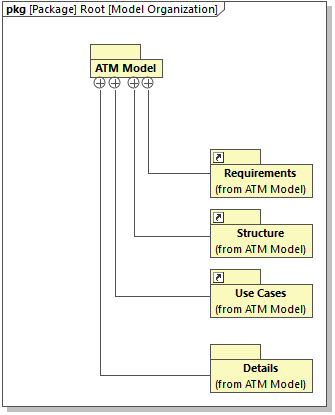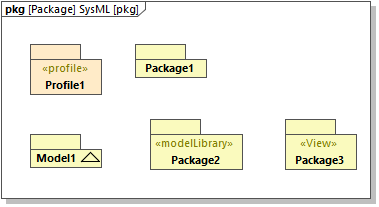Package Diagram
The Package diagram is used to organize model elements into packageable elements. In such diagrams, you can also define dependencies between packages and model elements within the package. For example, the diagram below illustrates the high-level organization of the model defined in the Bank_SysML.ump demo project from the C:\Users\<username>\Documents\Altova\UModel2025\UModelExamples directory. The links available for Requirements, Structure, and Use Cases point to the respective packages in the same model, see also Hyperlinking Elements.

Package diagram
The Package diagram illustrated above is just one of the ways to organize of a model; you can, of course, organize a model by other aspects, for example, by system hierarchy or by diagram type.
In a package diagram, you can add various elements to the diagram in the standard way, by clicking the respective toolbar buttons (such as Package ![]() , Profile
, Profile ![]() , or View
, or View ![]() ) and then clicking inside the diagram. Note, however, that some package specializations may not have commands available as toolbar buttons, in which case you can add them as follows:
) and then clicking inside the diagram. Note, however, that some package specializations may not have commands available as toolbar buttons, in which case you can add them as follows:
1.Click the Package  toolbar button and then click inside the diagram to add the new package.
toolbar button and then click inside the diagram to add the new package.
2.In the Properties window, select the check box with the desired stereotype (for example, «ModelLibrary»).

In the package diagram above, Package2 has the «ModelLibrary» stereotype and Package3 has the «View» stereotype. See also Applying Stereotypes.